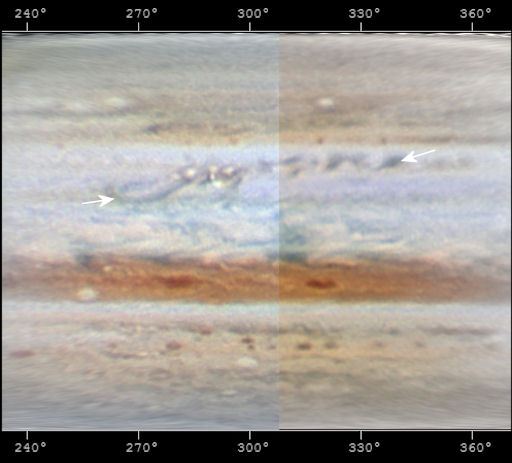AURORA ALERTS: Did you miss the Northern Lights? Next time get a wake-up call from Space Weather PHONE | | |
SPACE PLANE SET TO LAND: The US Air Force's X-37B space plane is reportedly going to land at the Vandenberg AFB in Californiia as early as this Friday, Dec. 3rd. The goal of the X-37B program is to trim turnaround time between space flights from months to days at a fraction of the cost of NASA's shuttle program. Prior to landing, the X-37B will make a series of nightime flybys over North America. Check the Simple Satellite Tracker or your cellphone for last-chance sighting opportunities.
POSSIBLE EARTH-DIRECTED ERUPTION: A magnetic filament in the sun's northeastern quadrant erupted during the late hours of Nov. 30th. Click on the image to play a movie recorded by NASA's Solar Dynamics Observatory--and pay attention to the bright splash below the movie arrow:

movie formats: 3.7 MB gif, 0.9 MB iPad, 0.4 MB iPhone
The blast produced a B-class solar flare and hurled a bright coronal mass ejection (CME) into space. Preliminary coronagraph images from NASA's twin STEREO spacecraft suggest that the cloud might be heading toward Earth. Further analysis is required, however, to confirm that the CME is coming our way. Stay tuned for updates.
RETURN OF JUPITER'S MISSING STRIPE: The revival of Jupiter's South Equatorial Belt (SEB), missing for nearly a year, is now well underway. The roiling, turbulent disturbance that heralds the brown stripe's full return stretches almost halfway around the giant planet. "Here is a projection map showing the revival on Nov. 29th," says amateur astronomer Wayne Jaeschke of West Chester, Pennsylvania. Note the region bracketed by arrows:

"I made the map by combining two pictures of Jupiter I took using my 14-inch Celestron telescope," says Jaeschke. "The disturbance has grown dramatically since it first appeared in late October." Indeed, it is now so large that even novice observers are starting to notice it in the eyepieces of backyard telescopes.
The spreading disturbance is not the SEB itself. Instead, it is thought to be a progressive clearing of high clouds that will eventually reveal the brown stripe hiding below. When the SEB finally returns, Jupiter will have two brown stripes again and the planet's appearance will return to normal. Meanwhile, amateur astronomers are encouraged to monitor the revival. Point your optics south after sunset: sky map.
more images: from Wayne Jaeschke of West Chester, PA; from Geoff Chester of Alexandria, Virginia; from John Nassr of Baguio, Philippines
November 2010 Aurora Gallery
[previous Novembers: 2009, 2008, 2007, 2006, 2004, 2003, 2002, 2001, 2000]
Potentially Hazardous Asteroids (
PHAs) are space rocks larger than approximately 100m that can come closer to Earth than 0.05 AU. None of the known PHAs is on a collision course with our planet, although astronomers are finding
new ones all the time.
On December 1, 2010 there were 1164 potentially hazardous asteroids.
Notes: LD means "Lunar Distance." 1 LD = 384,401 km, the distance between Earth and the Moon. 1 LD also equals 0.00256 AU. MAG is the visual magnitude of the asteroid on the date of closest approach. | | The official U.S. government space weather bureau |
| | The first place to look for information about sundogs, pillars, rainbows and related phenomena. |
| | Researchers call it a "Hubble for the sun." SDO is the most advanced solar observatory ever. |
| | 3D views of the sun from NASA's Solar and Terrestrial Relations Observatory |
| | Realtime and archival images of the Sun from SOHO. |
| | from the NOAA Space Environment Center |
| | the underlying science of space weather |

